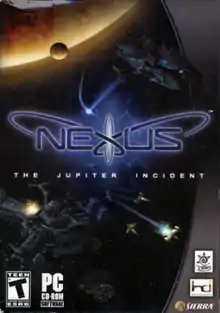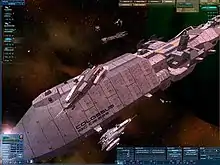Nexus: The Jupiter Incident
Nexus: The Jupiter Incident is a science fiction themed real-time tactics computer game developed by the Hungarian-based Mithis Entertainment. The game focuses on tactics and ship management instead of resource collection and base construction.
| Nexus: The Jupiter Incident | |
|---|---|
 | |
| Developer(s) | Mithis Entertainment |
| Publisher(s) | Vivendi Universal Games[lower-alpha 1] THQ Nordic (Steam) |
| Engine | Black Sun Engine |
| Platform(s) | Windows |
| Release | |
| Genre(s) | Real-time tactics, Space combat simulator, Science fiction |
| Mode(s) | Single player, multiplayer |

Gameplay and features
In each of the game's missions, the player is given a small number of large space ships (always less than ten, and sometimes just one or two), along with accompanying fighters and bombers. The ships are large and cumbersome, and the battles between fleets protracted, giving the game a noted cinematic feel.[1] Nexus uses the Blacksun Engine, made specifically for the game. Based on DirectX 9, it makes extensive use of vertex and pixel shaders, a parametric particle system, and other visual effects.
Story
The game is set in the 22nd Century. The player is Marcus Cromwell, a famed spacecraft captain whose father, Richard Cromwell, the first spaceborn human, captained the colony ship Noah's Ark through a wormhole near Mars that was presumed destroyed when the wormhole collapsed. The game begins with Cromwell setting out on the heavy corvette named Stiletto, manufactured by the company Spacetech, for Jupiter as standing escort for a pair of freighters.
Upon arrival at a pair of Spacetech-owned space stations in orbit around Callisto, Cromwell is retasked with intercepting a Kissaki Syndicate (a rival corporation to Spacetech) freighter that had been tagged for inspection, and later responding to an SOS call issued by Kissaki-owned station, fighting other corporations' ships and the station's automated defences. Inside the station was a cruiser-sized alien vessel, nicknamed the Angelwing`` by the Kissaki Syndicate, as well as information regarding another Kissaki station orbiting Pluto.
After a battle with a Syndicate fleet for the control of the Angelwing back at the Spacetech Callisto stations, Cromwell is given command of the cruiser and ordered to investigate the secret Kissaki base. At Pluto, an artificial intelligence, named Angel, uploads herself into the Angelwing and advises Cromwell to escape from an alien, orb-like entity - later known as a Mechanoid - through a nearby wormhole, which was the exact same wormhole as the one which collapsed near Mars.
Cromwell exits the wormhole and finds a system (named Noah) populated by the colonists from Noah's Ark, who survived the wormhole collapse and started a colony. The Noah Colony fights as mercenaries for an advanced but pacifist alien race, called the Vardrags, whose technology was given to colonists, against another powerful race, the bloodthirsty, reptilian Gorgs, and a local group of renegade Vardrag elites, known as the Raptors.
After aiding successful raid againt a Raptor base, Cromwell is enlisted to fight against the Gorg Empire. In fights against the Gorg, the Ghosts occasionally seem to help the Angelwing. However, all the races would soon find themselves facing their greatest threat: a virulent race of nanomachines called the Mechanoids. Nothing seems capable of stopping the Mechanoid invasion, and the Vardrag homeworld and Earth are overrun. Only an organic, insectile race, known as the energy-consuming Locusts, are immune to the Mechanoids. With technology adapted from the Locusts, Cromwell is able to rescue Earth and all the other solar systems and shut down the main control system of the Mechanoids, the Entity.
The fate of Angel, who fought the Mechanoids, is left ambiguous, as she was not shown leaving the Entity and returning to the Angelwing.
Aliens
Vardrags One of the most advanced races in the game. Their main home system is Chakaris (which was eventually evacuated after the attack of the Mechanoids on Chakaris III). They are very peaceful and have many strong allies. Their squadrons are led by the fearful Raptors. Though they do not know much of war tactics, they could gather very useful information on the enemy and could subsequently defeat them. The Catacalysm Missile is one of the deadliest creations of this alien group.
Gorgs Terrific and bloodthirsty and enemies of Vardrags and their allies. Though most of the clans of the Gorgs are brave, some, like the Raghara clan, execute many cowardly attacks. They do not even fear the Black Moon. The siege laser is one of the deadliest weapons of this alien group. Notable ships are Titan base and Warcry (Gorg Emperor's ship).
Ghosts Terribly intelligent creatures. Their home system is Mist and generally perform stealth missions for the Vardrags. Their ships have the special ability of camouflage.
Locust Insect like creatures. Like ants or honey bees, their community is divided into warriors, workers and queen. The Energy Skeeter is their most powerful weapon.
Raptors They are actually the fearsome allies of Vardrags, but some turn rogue against their masters and revolt against them. They are subsequently massacred by the Noah colonists.
History
Nexus: The Jupiter Incident was developed by the Hungarian-based Mithis Entertainment, intended by the publisher CDV originally as Imperium Galactica 3.[2] After the business relationship between Mithis and CDV broke apart and also the Imperium Galactica license got lost, the game was revised together with Most Wanted Entertainment as tactical strategy game.
The game was finally released in Europe in 2004[3] and in North America in 2005 for Windows.
Sequel
A technical demonstration video for the sequel, Nexus: The Jupiter Incident 2, was "leaked" to the Internet in 2006.
On August 16, 2011 Most Wanted Entertainment announced a sequel, named Nexus 2, on the crowdfunding website GamesPlant with a funding goal of €400,000.[4] The €104,867 pledged fell short of the €400,000 goal.[5]
In 2012 the original Nexus was digitally re-released on GOG.com.[6]
On September 28, 2012 a second campaign on Kickstarter was launched to fund the development of a sequel named Nexus 2: The Gods Awaken, but ultimately failed to raise the required amount, with only $161,731 of the $650,000 goal.[7]
Legacy
Nordic Games announced that they acquired the intellectual property on September 16, 2015.[8]
In March 2016 a patch was released for the game fixing long standing issues, like widescreen support.[9]
Reception
| Aggregator | Score |
|---|---|
| Metacritic | 77/100[10] |
| Publication | Score |
|---|---|
| Eurogamer | 7/10[11] |
| Game Informer | 8.25/10[12] |
| GamePro | |
| GameSpot | 8.3/10[1] |
| GameSpy | |
| GameZone | 7.5/10[15] |
| IGN | 8.2/10[16] |
| PC Gamer (US) | 83%[17] |
| VideoGamer.com | 8/10[18] |
| X-Play | |
| The Sydney Morning Herald |
The game received "generally favorable reviews" according to the review aggregation website Metacritic.[10] It was praised particularly for its visual effects, but criticized for its steep learning curve, trial and error gameplay, and poorly designed stealth missions.[1]
According to NPD Group, Nexus sold 11,500 copies by June 2005.[21]
References
- Jason Ocampo (March 9, 2005). "Nexus: The Jupiter Incident Review". GameSpot. Retrieved November 17, 2017.
- James Yee (October 10, 2012). "Nexus 2 Interview". Kickstarter. Archived from the original on November 18, 2013. Retrieved July 26, 2013.
Nexus had a long history already before it was published. The game was developed by Mithis, a Hungarian games development studio in Budapest. They had signed the game at the time with German publisher CDV. CDV decided that they wanted a license for the game and they acquired the license for Imperium Galactica. So, the game we know as Nexus would have been Imperium Galactica 3 as far as CDV was concerned.
- Stew Shearer (April 26, 2014). "Nexus: The Jupiter Incident - Rigid Space". The Escapist.
- "Most Wanted team up with GamesPlant to bring Nexus 2 to fans". Blue's News. 2011. Retrieved August 13, 2013.
- "Nexus 2". GamesPlant. Archived from the original on January 4, 2012.
- Fallout-Junge (September 26, 2012). "GOG: Nexus - The Jupiter Incident 60 Prozent günstiger" (in German). Gamers Global.
- "Nexus 2: The Gods Awaken (PC & MAC)". Kickstarter.
- "Nordic Games acquires 'Nexus'". Gamasutra. September 16, 2015.
- "Nexus just got really nice update". SpaceSimCentral.com. March 21, 2016. Archived from the original on September 13, 2016.
- "Nexus: The Jupiter Incident for PC Reviews". Metacritic. Retrieved November 18, 2017.
- Rob Fahey (November 3, 2004). "Nexus - The Jupiter Incident". Eurogamer. Retrieved November 18, 2017.
- Adam Biessener (March 2005). "Nexus: The Jupiter Incident". Game Informer. No. 143. p. 138. Archived from the original on September 23, 2009. Retrieved November 18, 2017.
- Deuce Magnum (March 10, 2005). "Nexus: The Jupiter Conspiracy [sic] Review for PC on GamePro.com". GamePro. Archived from the original on March 20, 2005. Retrieved November 18, 2017.
- Allen Rausch (March 4, 2005). "GameSpy: Nexus: The Jupiter Incident". GameSpy. Retrieved November 18, 2017.
- Matt Eberle (March 31, 2005). "Nexus - The Jupiter Incident - PC - Review". GameZone. Archived from the original on October 2, 2008. Retrieved November 18, 2017.
- Dan Adams (March 21, 2005). "Nexus: The Jupiter Incident". IGN. Retrieved November 18, 2017.
- "Nexus: The Jupiter Incident". PC Gamer. April 2005. p. 74.
- Adam Jarvis (November 25, 2004). "Nexus - The Jupiter Incident Review". VideoGamer.com. Retrieved November 18, 2017.
- Greg Bemis (March 7, 2005). "Nexus: The Jupiter Incident Review". X-Play. Archived from the original on March 9, 2005. Retrieved November 18, 2017.
- Bennett Ring (January 29, 2005). "Fight leader". The Sydney Morning Herald. Retrieved November 18, 2017.
- Saltzman, Marc (June 18, 2005). "Top PC games can end up in bargain bin". CNN. Archived from the original on July 2, 2005.
- Released under the Sierra Entertainment brand name
External links
- Nexus: The Jupiter Incident at MobyGames
- Nexus 2 Interview (October 2012, archived)